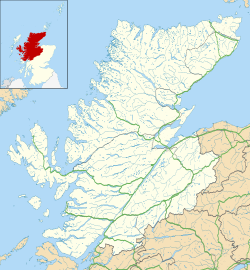Ardvreck Castle
This article needs additional citations for verification. (May 2014) |
| Ardvreck Castle | |
|---|---|
| Sutherland in | |
| File:NC500- Glencoe2.jpg Present day ruins of the castle | |
| Coordinates | 58°09′59″N 4°59′40″W / 58.166389°N 4.994444°W |
| Site information | |
| Condition | Ruined |
| Site history | |
| Built | 1590 |
| Built by | Clan MacLeod |
| Materials | Stone |
| Fate | Destroyed in 1672 by Clan MacKenzie |
Ardvreck Castle is a ruined castle dating from the 16th century which stands on a rocky promontory jutting out into Loch Assynt in Sutherland, Scotland. One can reach the ruins by driving along the A837, which follows the north shore of Loch Assynt from the village of Inchnadamph.
History of Ardvreck
The castle was built in about 1590 by the Clan MacLeod family, who owned Assynt and the surrounding area from the 13th century onwards.
Ardvreck is famous as the place where Montrose was handed over in 1650 to the Covenanter forces by McLeod, Laird of Assynt. The true history of this event is unclear. One account is that McLeod, loyal to the Covenanters, arrested the weary, fleeing, Montrose and held him. Another is that he provided comfortable shelter, but betrayed Montrose for the sake of the £25,000 reward.[1]
Clan Mackenzie attacked and captured Ardvreck Castle in 1672, and then took control of the Assynt lands. In 1726 they constructed a more modern manor house nearby, Calda House,[2] which takes its name from the Calda burn beside which it stands. A fire destroyed the house under mysterious circumstances one night in 1737 and both Calda House and Ardvreck Castle stand as ruins today.[3] They are designated as scheduled monuments.[4][5]
Architecture
Ardvreck Castle was a rectangular-shaped keep comprising three storeys.[6] Under the castle the vaulted basement is pierced by gunloops, and the round stair turret is corbelled out to support a square caphouse. Despite the small size of the ruined tower, Ardvreck was originally a large and imposing structure, and it is thought that the castle included a walled garden and formal courtyard. The remains of the foundations can still be seen and cover a large area. All that remains standing is a tower and part of a defensive wall. When the waters of the loch rise very high, the peninsula on which the castle stands can be cut off from the mainland.
References
- ^ Montrose, by C.V. Wedgwood, page 137.
- ^ http://www.inch-lodge.co.uk/historicassynt/calda.html
- ^ "Archived copy". Archived from the original on 8 May 2006. Retrieved 15 November 2006.
{{cite web}}: CS1 maint: archived copy as title (link) - ^ Historic Environment Scotland. "Ardvreck Castle (SM1895)". Retrieved 24 February 2019.
- ^ Historic Environment Scotland. "Calda House, house 475m SE of Ardvreck Castle, Inchnadamph (SM6533)". Retrieved 24 February 2019.
- ^ http://www.inch-lodge.co.uk/historicassynt/ardvreck.html
- Clan MacLeod, Alan MacNeil, Lomond Books
- Clan MacLeod (Clan History), I.F. Grant, Johnston and Bacon Books


